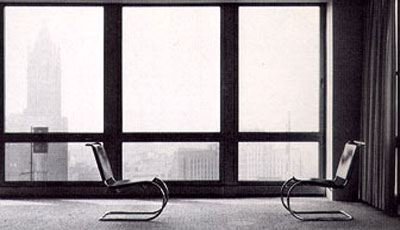You are viewing an ancient version of
wheatdesign.com. Please use the
current version instead. There's a handy search engine
and an index of all
blog posts to help you locate what you need.

wheatdesign.com
Introduction
For as long as I've been interested in architecture, I've been a fan of Mies van der Rohe. When I last redesigned my site, I started using an image of Farnsworth House as the masthead graphic for the design section. Ever since then, I have gotten a lot of hits from people looking to learn more about Mies and his work. So I decided to put something together for the benefit of those fine folks. I hope you enjoy it.
For as long as I've been interested in architecture, I've been a fan of Mies van der Rohe. When I last redesigned my site, I started using an image of Farnsworth House as the masthead graphic for the design section. Ever since then, I have gotten a lot of hits from people looking to learn more about Mies and his work. So I decided to put something together for the benefit of those fine folks. I hope you enjoy it.
Biography
Ludwig Mies van der Rohe was born in Aachen, Germany on March 29, 1886. After working in his family stone carving business, he arrived in Berlin in 1905. Though he had no formal training in architecture, Mies got his start working for architect and furniture designer Bruno Paul (1874-1968), which occupied him from 1905-1907. From 1908-1912, he worked in the studio of architect Peter Behrens (1868-1940)--who also served as a teacher for Walter Gropius and Le Corbusier. Mies opened his own practice in Berlin in 1912.
Ludwig Mies van der Rohe was born in Aachen, Germany on March 29, 1886. After working in his family stone carving business, he arrived in Berlin in 1905. Though he had no formal training in architecture, Mies got his start working for architect and furniture designer Bruno Paul (1874-1968), which occupied him from 1905-1907. From 1908-1912, he worked in the studio of architect Peter Behrens (1868-1940)--who also served as a teacher for Walter Gropius and Le Corbusier. Mies opened his own practice in Berlin in 1912.
Mies became director of the
Bauhaus
in 1930 and remained in that position until the school was closed by the
Nazis in 1933.
Mies came to Chicago in 1938, at the invitation of what would shortly
become the Illinois Institute of Technology (formed by the merging of the
Armour Institute and the Lewis Institute in 1940). He was hired to head
the architecture department. His first major assignment was to redesign
the entire campus--which he did to great acclaim. Mies worked at IIT for
twenty years (1938-1958), becoming a US citizen in 1944. He also maintained
a private practice in Chicago.
Mies died on August 17, 1969, in Chicago, Illinois, USA.
Some Major Works
Barcelona Pavilion (Barcelona, Spain, 1928-1929)
IIT Campus (Chicago, Illinois, 1940s)
Farnsworth House (Plano, Illinois, 1946-1950)
Lakeshore Drive Apartments (Chicago, Illinois, 1951)
The Seagram Building (New York, 1954-1958)
Barcelona Pavilion (Barcelona, Spain, 1928-1929)
IIT Campus (Chicago, Illinois, 1940s)
Farnsworth House (Plano, Illinois, 1946-1950)
Lakeshore Drive Apartments (Chicago, Illinois, 1951)
The Seagram Building (New York, 1954-1958)